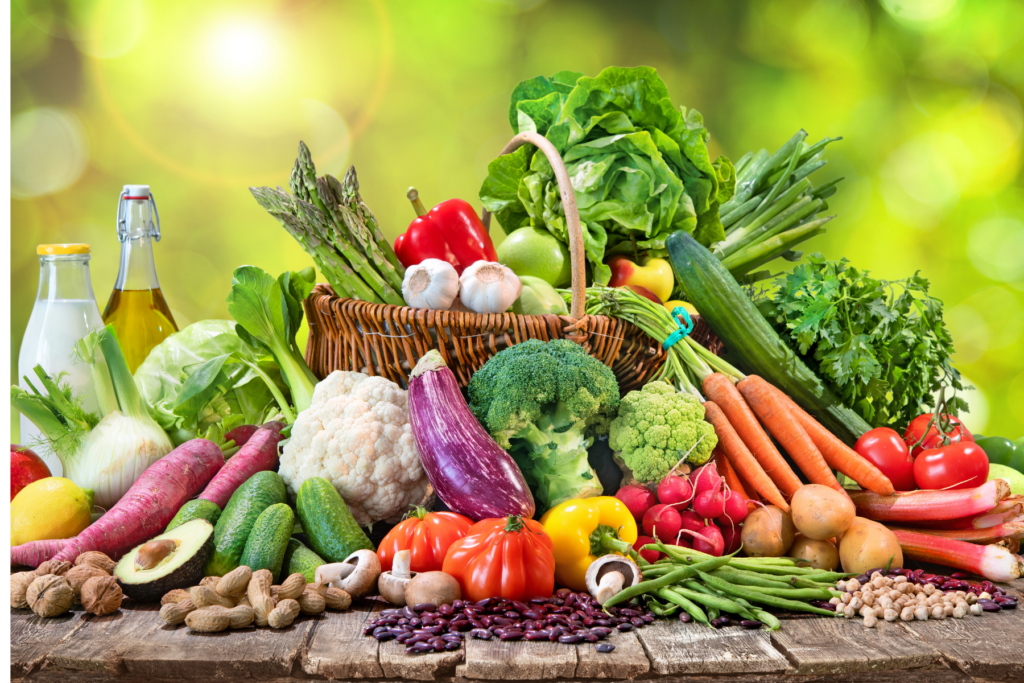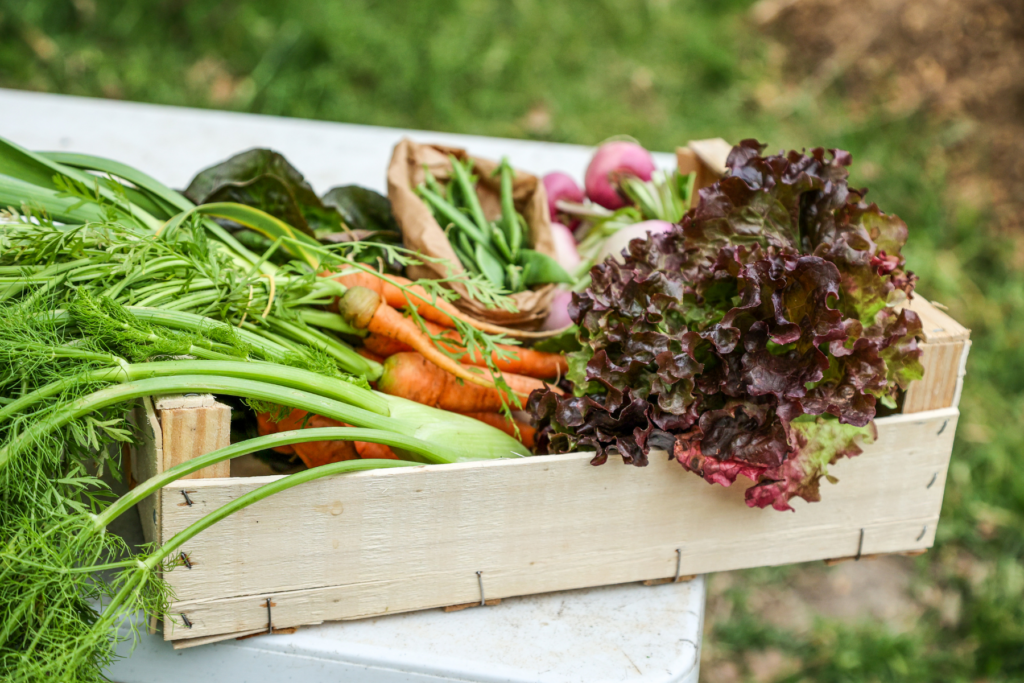


Organic vs. Conventional Food: Let’s Talk!
As a parent, you want the best for your child, including the food they eat! One of the most common questions parents ask is whether they should prioritize organic foods over conventional foods. This blog dives into what organic food is, breaks down organic label terms, explores the current research, and discusses the impact of organic foods on children’s health. By the end, you’ll have the evidence-based information you need to make informed decisions for your family.
Before we get into the nitty gritty, the bottom line is that all age groups are not consuming enough fruits and vegetables. The CDC reports that only one in ten people in the U.S. consumes an adequate fruit and vegetable intake. Getting the appropriate amount of nutrients each day is WAY more important than choosing between organic foods vs conventional. All food produced in the U.S. must meet the same safety standards regardless of how the food is grown. Just because a food is conventionally grown does not mean it is not safe and nutritious.
What Does “Organic” Mean?
Organic foods are grown and processed according to specific regulations that are outlined by the USDA. To simplify it, the USDA States the definition as “organic is a label that indicates that a food or agricultural product has been produced according to the USDA organic standards, which require operations to use practices that cycle resources, conserve biodiversity, and preserve ecological balance” (1).
The organic standards are different depending on the food item. These are the guidelines according to the USDA for each type of food (1):
Produce & Grains
- Natural fertilizers
- Eco-friendly pest control
- Protects soil and water
Meat, Dairy, & Eggs
- Roam freely outdoors
- Protects animal welfare
- No growth hormones or antibiotics
Packaged Goods
- No GMOs
- Traced from farm to store
- No artificial colors, flavors, or preservatives
The term organic is protected in the United States, therefore, only foods assessed by the USDA can include the word organic. The actual USDA organic seal is a registered trademark, which allows USDA to enforce criminal penalties against uncertified operations falsely using the seal to misrepresent products as organic.
All this to say, when you see a food that says it is organic, it is definitely organic!
Quick Note: Many small farmers lack the money and time to go through the rigorous process of becoming a certified organic grower. They may meet all the qualifications but not have the time and effort to go through the legal system to obtain the stamp of approval. I thought this was important to mention that not all products without the organic label may be any different than products with the organic label.
Understanding Organic Labels
Now that you understand what organic generally is and how it is regulated, there is a whole another discussion on what organic might mean when used on a food label. It can be confusing to navigate, but here is what each phrase means (2):
- 100% Organic: All ingredients used in the product, including processing aids, must be certified organic. Products that are 100% organic can display the USDA Organic seal.
- Organic: At least 95% of the ingredients (by weight) are certified organic, with the remaining 5% coming from an approved list of non-organic substances. These products can also choose to display the USDA Organic seal.
- Made with Organic Ingredients: These products contain at least 70% certified organic ingredients. The USDA Organic seal cannot be used, but the label can list up to three organic ingredients (e.g., “made with organic oats and almonds”). The remaining non-organic ingredients are produced without using prohibited practices (genetic engineering, for example) but can include substances that would not otherwise be allowed in 100% organic products.
- Specific Organic Ingredients: For products with less than 70% organic ingredients, the term “organic” cannot be used throughout the package; it can only appear in the ingredients list. You may find something like “Organic Blueberry” in the ingredient list, which means only the ingredient with the label is organic.
Understanding these labels can help you walk into the grocery store feeling confident in your decisions and having the ability to choose products that meet your family’s preferences and priorities.
The Research on Organic Foods
Now it’s time to dive into the research! Before deciding whether to spend the extra money on organic food, it’s important to know, based on various studies, what the difference truly is. Unfortunately, research on organic foods and their health benefits is still evolving, but a few areas have been studied. The current evidence base does not allow a definitive statement on the health benefits of organic dietary intake. However, a growing number of important findings are being reported from observational research of potential health benefits with organic food consumption. Future studies are needed that focus on long-term whole-diet substitutions with organic foods to truly determine measurable health differences.
Before diving into the science we have available, please take note that there are an incredible number of factors that impact the level of nutrients in food, including the variations in plants, quality of soil, when the plants were harvested, how long the plants were stored etc. So take this information lightly and remember that increased fruit and vegetable intake in any form is beneficial.
Here’s what the science says about organic foods as of now:
- Nutritional Content in Produce:
- Organic fruits and vegetables have been shown to contain higher levels of certain nutrients, particularly antioxidants. A meta-analysis found that organic produce had higher concentrations of antioxidants such as flavonoids, polyphenols, and carotenoids, as well as lower amounts of pesticide residues (3). We also have found that these compounds are associated with reduced inflammation and a lower risk of chronic diseases, including CVD, neurodegenerative diseases, and certain cancers (4).
- However, there appears to be little variation between organic and conventional food products in terms of macronutritional value (protein, fat, carbohydrate, and fiber) (5).
- A question that commonly comes up is nitrates. Click here to read our blog about nitrates and your little one.
- Additional research needs to be conducted to come to a definitive decision on the differences in mineral and vitamin content.
- Nutritional Content in Meats:
- Organic meats come from animals raised on organic feed and without the use of antibiotics or growth hormones. Studies suggest that organic meat may have a slightly healthier fat profile (8). For instance, organic beef and chicken have been shown to contain higher levels of omega-3 fatty acids.
- Another study reported that organic dairy and meat had about 37% more omega-3 fatty acids than their conventional counterparts (9).
- Conventional meats, however, often have similar levels of protein and micronutrients, such as iron and zinc, compared to organic meats. The differences lie more in the fat quality and decreased pesticide residues.
- Nutritional Content in Grains:
- Research has demonstrated that some grains, such as corn grain and wheat flour, can contain more minerals and vitamins (17).
- Generally, the overall nutritional quality of organic grains is comparable or slightly superior to conventional grains.
- Check out our blog to learn more about grains and your little one!
- Nutritional Content in Dairy:
- Studies have found that organic dairy products, such as milk, yogurt, and cheese, have a better omega-3 to omega-6 fatty acid ratio and generally higher omega-3 levels when compared to conventional dairy (10).
- Organic dairy also tends to have higher levels of conjugated linoleic acid (CLA) and alpha-lipoic acid (ALA), fatty acids that have been shown to have their unique health benefits (11).
- Nutritional Content in Processed Foods:
- Organic processed foods, such as cereals, snacks, etc, must meet the guidelines outlined earlier regarding the ingredients used.
- One important thing to note with organic processed foods is that they still can contain added sugars, have high levels of sodium, or lack nutrients essential for your little one. Be sure to look at the label when purchasing these foods to see if they fit into their diet.
- Potential For Lower Pesticide Residues:
- Organic foods generally contain lower levels of conventional pesticide residues compared to conventional foods. Various studies have found that individuals consuming an organic diet have lower levels of pesticides via urine output when compared to those consuming conventional diets (12).
- Important to note that the pesticide levels in conventional foods are always below the regulatory safety limits; however, concerns about long-term exposure remain, and at this time, research has not come to a conclusion on this topic.
- One last thing to note is that ‘organic pesticides’ exist and are used in organic foods as well. There is not much research on this topic, but there are certain pesticides that have been approved for use in organic agriculture according to the U.S. Department of Agriculture (USDA) (13). Further research should be done on this topic to conclude what this means.
- Heavy Metals and Contaminants:
- A few studies found that organic foods have been shown to have lower levels of toxic metabolites, including heavy metals such as cadmium and synthetic fertilizers (3,6).
Overall, the differences in nutritional content between organic and conventional foods vary by food type. While organic foods often have some advantages in terms of antioxidants, healthy fats, and lower conventional pesticide residues, the differences in various nutrients, vitamins, and minerals are less pronounced.
A recent systematic study done in 2024 showed that we just do not have enough information to make firm claims about organic fruits and vegetables across the board being healthier than conventional fruits and veggies. There is a lack of data and concrete study designs to clearly show a consistent difference.
How This All Applies to Children
While organic foods may have some advantages in reducing conventional pesticide exposure, or certain nutrients have a higher content, it’s important to remember that there is a lot more research to be done on this topic, and we cannot draw definitive conclusions.
Nutritionally, the most significant factor is ensuring your child eats a variety of fruits, vegetables, whole grains, and lean proteins—whether organic or not.
Summary
Deciding between organic and conventional foods for your child can feel overwhelming, but the choice doesn’t have to be all-or-nothing. Organic foods may reduce conventional pesticide exposure, and potentially offer slight nutritional advantages, but if you can’t afford them or access them, conventional products are safe and nutritious and should not be feared. Focus on variety, balance, and whole, minimally processed foods, and make organic choices if they align with your family’s values and budget.
As a pediatric dietitian, my goal is to empower you with evidence-based information to make the best choices for your family. If you have specific concerns about your child’s diet or want personalized guidance, don’t hesitate to reach out for a consultation!
References:
2- https://www.usda.gov/about-usda/news/blog/organic-101-what-usda-organic-label-means
3- Barański, M., Srednicka-Tober, D., Volakakis, N., Seal, C., Sanderson, R., Stewart, G. B., Benbrook, C., Biavati, B., Markellou, E., Giotis, C., Gromadzka-Ostrowska, J., Rembiałkowska, E., Skwarło-Sońta, K., Tahvonen, R., Janovská, D., Niggli, U., Nicot, P., & Leifert, C. (2014). Higher antioxidant and lower cadmium concentrations and lower incidence of pesticide residues in organically grown crops: a systematic literature review and meta-analyses. The British journal of nutrition, 112(5), 794–811. https://doi.org/10.1017/S0007114514001366
4- Willcox, J. K., Ash, S. L., & Catignani, G. L. (2004). Antioxidants and prevention of chronic disease. Critical reviews in food science and nutrition, 44(4), 275–295. https://doi.org/10.1080/10408690490468489
5- Vigar, V., Myers, S., Oliver, C., Arellano, J., Robinson, S., & Leifert, C. (2019). A Systematic Review of Organic Versus Conventional Food Consumption: Is There a Measurable Benefit on Human Health?. Nutrients, 12(1), 7. https://doi.org/10.3390/nu12010007
6- Brantsæter, A. L., Ydersbond, T. A., Hoppin, J. A., Haugen, M., & Meltzer, H. M. (2017). Organic Food in the Diet: Exposure and Health Implications. Annual review of public health, 38, 295–313. https://doi.org/10.1146/annurev-publhealth-031816-044437
7- Smith-Spangler, C., Brandeau, M. L., Hunter, G. E., Bavinger, J. C., Pearson, M., Eschbach, P. J., Sundaram, V., Liu, H., Schirmer, P., Stave, C., Olkin, I., & Bravata, D. M. (2012). Are organic foods safer or healthier than conventional alternatives?: a systematic review. Annals of internal medicine, 157(5), 348–366. https://doi.org/10.7326/0003-4819-157-5-201209040-00007
8- Ribas-Agustí, A., Díaz, I., Sárraga, C., García-Regueiro, J. A., & Castellari, M. (2019). Nutritional properties of organic and conventional beef meat at retail. Journal of the science of food and agriculture, 99(9), 4218–4225. https://doi.org/10.1002/jsfa.9652
9- Średnicka-Tober, D., Barański, M., Seal, C., Sanderson, R., Benbrook, C., Steinshamn, H., Gromadzka-Ostrowska, J., Rembiałkowska, E., Skwarło-Sońta, K., Eyre, M., Cozzi, G., Krogh Larsen, M., Jordon, T., Niggli, U., Sakowski, T., Calder, P. C., Burdge, G. C., Sotiraki, S., Stefanakis, A., Yolcu, H., … Leifert, C. (2016). Composition differences between organic and conventional meat: a systematic literature review and meta-analysis. The British journal of nutrition, 115(6), 994–1011. https://doi.org/10.1017/S0007114515005073
10- Palupi, E., Jayanegara, A., Ploeger, A., & Kahl, J. (2012). Comparison of nutritional quality between conventional and organic dairy products: a meta-analysis. Journal of the science of food and agriculture, 92(14), 2774–2781. https://doi.org/10.1002/jsfa.5639
11- Nguyen, H., Pellegrini, M. V., & Gupta, V. (2024). Alpha-Lipoic Acid. In StatPearls. StatPearls Publishing.
12- Vigar, V., Myers, S., Oliver, C., Arellano, J., Robinson, S., & Leifert, C. (2019). A Systematic Review of Organic Versus Conventional Food Consumption: Is There a Measurable Benefit on Human Health?. Nutrients, 12(1), 7. https://doi.org/10.3390/nu12010007
13- https://www.usda.gov/about-usda/news/blog/organic-101-allowed-and-prohibited-substances
https://pmc.ncbi.nlm.nih.gov/articles/PMC11819487
Want more? My course is a 100% evidence-based approach to starting solids in a way that encourages a healthy dietary pattern from the start.
Check out the Starting Solids 101 Course now!
Access Course Now

Cinthia Scott is a Registered Dietitian (RD) and International Board Certified Lactation Consultant (IBCLC) with over 10 years experience in the field of dietetics. Cinthia focuses on ensuring optimal nutrition in the first 1000 days of life to ensure optimal growth and development as well as set the stage for long-term health. Cindy is an author, starting solids expert, and advocate for caregivers receiving evidence based education and support surrounding breastfeeding and starting solids.
Cinthia is co-author of the 101beforeone Starting Solids Book, “101beforeone -baby-led feeding cookbook,” and is the founder and owner of The Baby Dietitian LLC which is her private practice built to provide virtual 1:1 services for caregivers surrounding infant nutrition, toddler nutrition, and breastfeeding support. Cinthia is also the creator of the Starting Solids 101 Program which provides caregivers 1:1 support from a Pediatric Dietitian on how to provide optimal nutrition from the start and create healthy eating habits that will last their whole lifetime. To work with Cinthia, you can access her services here.
Cinthia provides tons of free information for parents on her social media accounts as well.
- Instagram: @The.Baby.Dietitian
- Tiktok: @The.Baby.Dietitian
